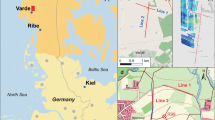Abstract
The integrated approach to solving complicated geological, hydrological and environmental problems is now widely used in geophysics. Among all the geophysical methods, electrical and electromagnetic techniques are the most popular in groundwater exploration due to the close relationship between electrical conductivity and some hydrogeological properties of the aquifer (e.g. porosity, clay content, mineralization of the groundwater and degree of water saturation). Case histories presented here show that by proper combination of different techniques such as conventional direct current (DC) resistivity as well as the more advanced electromagnetic (EM) methods and the most recent nuclear magnetic resonance (NMR) tomography, the reliability of interpretation as compared to that typical for the individual methods can be significantly improved.
Similar content being viewed by others
References
Arcone, A. A.: 1979, ‘Resolution Studies in Airborne Resistivity Surveying at VLF’,Geophysics 44, 937–946.
Beck, A. E.: 1981,Physical Principles of Exploration Methods, Macmillan Press Ltd., London.
Beeson, S. and Jones, R. C.: 1988, ‘The Combined EMT/VES Geophysical Method for Siting Boreholes’,Ground Water 26, 54–63.
Emsley, J. W., Feeney, J. and Sutcliffe, L. H.: 1967,High Resolution Nuclear Magnetic Resonance Spectroscopy, Pergamon Press, Oxford.
Fitterman, D. V. and Hoekstra, P.: 1984, ‘Mapping of Saltwater Intrusion with Transient Electromagnetic Soundings,Proceedings of NWWA/EPA Conference on Surface and Borehole Geophysical Methods in Groundwater Investigation, pp. 429–454.
Fitterman, D. V. and Stewart, M. T.: 1986, ‘Transient Electromagnetic Soundings for Groundwater’,Geophysics 51, 995–1006.
Fitterman, D. V., Menges, C. M., Al Kamali, A. M. and Jama, F. E.: 1991, ‘Electromagnetic Mapping of Buried Paleochannels in Eastern Abu Dhabi Emirate, U.A.E.’,Geoexploration 27, 111–133.
Goldman, M., Arad, A., Kafri, U., Gilad, D. and Melloul, A.: 1989, ‘Detection of Freshwater/Seawater Interface by the Time Domain Electromagnetic (TDEM) Method in Israel’,Proc. 10th SWIM, Ghent, 1988, pp. 329-344.
Goldman, M., Eckard, M., Rabinovich, M. and Zacher, G.: 1993, ‘One-Dimensional Joint Inversion of 3-D Transient Electromagnetic (TEM) and Audiomagnetotelluric (AMT) Data, Extended Abstract of Papers, EAEG, 55th Meeting and Technical Exhibition, Paper D018.
Goldman, M., Rabinovich, B., Gev, I., Gilad, D., Rabinovich, M. and Schirov, M.: 1994, ‘Application of the Integrated NMR/TDEM Method in Groundwater Exploration in Israel’,Journal of Applied Geophysics 31, 27–52.
Keller, G.V. and Frischknecht, F.C.: 1966,Electrical Methods in Geophysical Prospecting, Pergamon Press, Oxford.
McNeill, J. D.: 1980, ‘EM34-3 Survey Interpretation Techniques’,Technical Note TN-8, Geonics Ltd., Toronto.
McNeill, J. D.: 1990, ‘Use of Electromagnetic Methods for Groundwater Studies’, in: S. Ward (ed.)Geotechnical and Environmental Geophysics, SEG, Tulsa, Oklahoma, USA, 191–218.
Mills, T., Hoekstra, P., Blohm, M. and Evans, L.: 1988. ‘Time Domain Electromagnetic Soundings for Maping Seawater Intrusion in Monterey County’,California, Ground Water,26, 771–782.
Nabighian, M.: 1979, ‘Quasi-Static Transient Response of a Conducting Half-Space - An Approximate Representation’,Geophysics,44, 1700–1706.
Ogilvy, R. D., Cuadra, A., Jackson, P. D. and Monte, J. L.: 1991, ‘Detection of an Air-Filled Drainage Gallery by the VLF Resistivity Method’,Geophysical Prospecting 39, 845–859.
Palacky, G. J.: 1987, ‘Resistivity Characteristics of Geologic Targets’, in: M. Nabighian (ed.)Electromagnetic Methods in Applied Geophysics - Theory, SEG, Tulsa, Oklahoma, USA, 53–129.
Palacky, G. J. and West, G. F.: 1987, ‘Airborne Electromagnetic Methods’, in: M. Nabighian (ed.)Electromagnetic Methods in Applied Geophysics - Application, SEG, Tulsa, Oklahoma, USA, 811–879.
Palacky, G. J. and Stephens, L. E.: 1990, ‘Mapping of Quarternary Sediments in Northeastern Ontario using Ground Electromagnetic Methods’,Geophysics 55, 1596–1609.
Paterson, N. R. and Ronka, V.: 1971, ‘Five Years of Surveying with the Very Low Frequency Electromagnetic Method’,Geoexploration 9, 7–26.
Raiche, A. P., Jupp, D. L. B., Rutter, H. and Vozoff, K.: 1985, ‘The Joint use of Coincidental Loop Transient Electromagnetic and Schlumberger Sounding to Resolve Layered Structures’,Geophysics 50, 1618–1627.
Roy, K. K. and Elliot, H. M.: 1980, ‘Resistivity and IP Survey for Delineating Saline Water and Freshwater Zones’,Geoexploration 18, 145–162.
Schirov, M., Legchenko, A. and Creer, G.: 1991, ‘A New Direct Non-invasive Groundwater Detection Technology for Australia, Exploration Geophysics’,22, 333–338.
Scintrex, 1988, VLF-3/4 Electromagnetic Receiver, Operation Manual, Scintrex, Canada.
Seigel, H. O.: 1974, ‘The Magnetic Induced Polarization (MIP) Method’,Geophysics 30, 321–329.
Semenov, A. G., Burshtein, A. I., Pusep, A. Ju. and Schirov, M. D.: 1988, ‘A Device for Measurement of Underground Mineral Parameters’, USSR Patent 1079063.
Smith, B. D. and Ward, S. H.: 1974, ‘On the Computation of Polarization Ellipse Parameters’,Geophysics 39, 867–869.
Stewart, M. T.: 1982, ‘Evaluation of Electrimagnetic Methods for Rapid Mapping of Saltwater Interfaces in Coastal Aquifers’,Ground Water 20, 538–545.
Stewart, M. and Bretnall, R.: 1986, ‘Interpretation of VLF Resistivity Data for Groundwater Contamination Surveys’,Proceedings of NWWA Conference on Surface and Borehole Geophysical Methods, pp. 71–75.
Swift, C. M.: 1987, ‘Fundamentals of the Electromagnetic Method’, in: M. Nabighian (ed.),Electromagnetic Methods in Applied Geophysics - Theory, SEG, Tulsa, Oklahoma, USA, 5–10.
Telford, W. M., Geldart, L. P. andSheriff, R. E., 1990,Applied Geophysics Second Edition, Cambridge University Press, Cambridge.
Vozoff, K. and Jupp, D. L. B.: 1975, ‘Joint Inversion of Geophysical Data’,Geophysical Journal of the Royal Astronomical Society 42, 977–991.
Wright, J. L.: 1988, VLF interpretation manual.
Zonge, K. L. and Hughes, L. J.: 1991, ‘Controlled Source Audio-Frequency Magnetotellurics’, in: M. Nabighian (ed.)Electromagnetic Methods in Applied Geophysics - Application, SEG Tulsa, Oklamona, USA, pp. 811–879.
Author information
Authors and Affiliations
Rights and permissions
About this article
Cite this article
Goldman, M., Neubauer, F.M. Groundwater exploration using integrated geophysical techniques. Surv Geophys 15, 331–361 (1994). https://doi.org/10.1007/BF00665814
Received:
Revised:
Issue Date:
DOI: https://doi.org/10.1007/BF00665814




